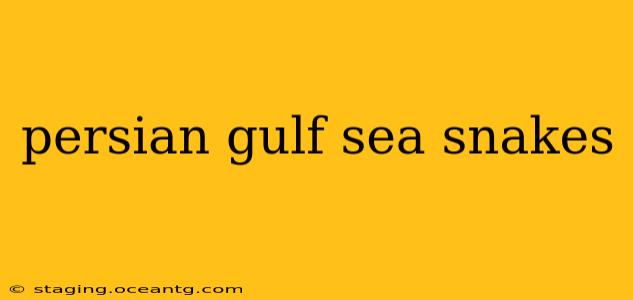The Persian Gulf, a vital waterway teeming with life, is also home to a fascinating and sometimes feared group of reptiles: sea snakes. These sleek, venomous creatures play a crucial role in the gulf's delicate ecosystem, yet their secretive nature and potent venom mean they are often misunderstood. This comprehensive guide delves into the world of Persian Gulf sea snakes, exploring their species, behavior, venom, and the importance of their conservation.
What types of sea snakes live in the Persian Gulf?
Several species of sea snakes inhabit the Persian Gulf, primarily belonging to the Hydrophiinae subfamily. Pinpointing exact species numbers is challenging due to ongoing research and taxonomic revisions, but common genera include Hydrophis, Aipysurus, and Lapemis. These snakes are highly adapted to a marine environment, with laterally compressed bodies, paddle-like tails for propulsion, and specialized salt glands to excrete excess salt ingested through seawater. Specific identification often requires expert analysis of physical characteristics and geographical location.
Are Persian Gulf sea snakes venomous?
Yes, Persian Gulf sea snakes are venomous. However, it's crucial to understand that their venom, while potent, is typically not as deadly to humans as that of some terrestrial snakes. Most sea snake bites are defensive, occurring when a snake is accidentally handled or stepped on. While serious medical attention is always warranted after a sea snake bite, fatalities are relatively rare compared to bites from other venomous snakes. The venom's composition and potency can vary between species within the Persian Gulf, adding another layer of complexity.
How dangerous are Persian Gulf sea snakes to humans?
While possessing potent venom, Persian Gulf sea snakes are generally not aggressive towards humans. Most bites occur through accidental contact, typically when people are wading in shallow waters, handling fishing nets, or engaging in activities close to the snake's habitat. The risk of being bitten is relatively low, provided individuals exercise caution and avoid unnecessarily handling or provoking the snakes. The severity of a bite depends on factors such as the species of snake, the amount of venom injected, and the individual's health and response to the venom.
What should you do if you are bitten by a Persian Gulf sea snake?
A sea snake bite is a serious medical emergency requiring immediate attention. Do not attempt to self-treat. The first step is to remain calm and seek immediate medical help. If possible, try to note down characteristics of the snake (size, color, pattern) to aid identification. Immobilize the bitten limb to slow the spread of venom, and avoid applying a tourniquet or cutting the wound. Medical professionals will administer appropriate antivenom and provide necessary support.
What is the role of sea snakes in the Persian Gulf ecosystem?
Persian Gulf sea snakes play a significant role in maintaining the balance of the marine ecosystem. They are primarily piscivorous (fish-eating), feeding on a variety of fish species. This predatory role helps regulate fish populations, preventing overpopulation of certain species. In turn, sea snakes themselves are prey for larger marine animals, furthering the intricate web of the food chain within the Gulf.
How are Persian Gulf sea snakes being conserved?
The conservation status of many Persian Gulf sea snake species is currently being assessed, with many facing threats from habitat degradation, pollution, and accidental bycatch in fishing activities. Conservation efforts typically focus on promoting sustainable fishing practices, reducing pollution in coastal areas, and protecting critical habitats. Research into their population dynamics, venom composition, and behavior is also crucial for effective conservation strategies.
Conclusion
The Persian Gulf sea snakes, though venomous, are vital components of the region's intricate marine ecosystem. Understanding their behavior, venom potency, and ecological role is key to fostering responsible interactions and effective conservation strategies. Respecting their natural habitat and avoiding unnecessary contact are essential steps in ensuring the continued survival of these fascinating creatures. Further research and conservation efforts are crucial to safeguarding their future within the Persian Gulf.
